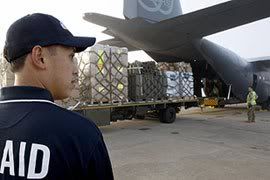-------------
-----------

New Zealand sent $1.2 million in aids
Fijian naval vessels and Australian and New Zealand aircraft headed to isolated islands Thursday to assess the devastation from this week's cyclone.
Cyclone Tomas, which packed average winds of 175 kilometres (109 miles) an hour, caused widespread devastation in Fiji's north and east on Monday and Tuesday, although only one death has so far been confirmed.
Some of the isolated islands remain out of contact and officials said Tuesday around half of the buildings in the eastern Lau group may have been destroyed or damaged.
But aerial surveys of some northern areas on Wednesday suggested damage may not be as bad as initially feared.
The top official for the northern region, Inia Seruiratu, told Fiji commercial radio that an aerial inspection of the northern island of Cikobia, where communications had been cut since the cyclone struck on Monday, had revealed widespread damage to vegetation, buildings and infrastructure.
"But overall, the extent of the damage is not as bad as we anticipated, so that is good news," he said.
New Zealand air force squadron leader Kavae Tamariki said low cloud had hampered the inspection by the C130 Hercules aircraft.
"From the air there were pockets of destruction but it didn't seem as bad as we initially thought," Tamariki told Radio New Zealand.
Three Fijian naval vessels left the capital Suva Wednesday night for regions in the north and east to assess damage and deliver relief supplies, including food, water containers, tents and tarpaulins.
Officials in Fiji have expressed concern over the potential outbreak of water-borne diseases in the aftermath of Cyclone Tomas that battered the island-nation.
The South Pacific country was suffering from an outbreak of typhoid even before the storm, and health authorities now fear it could spread at evacuation centres.
The health ministry has already deployed teams to the eastern and central divisions to assess health risks, Radio New Zealand International (RNZI) said on Thursday.
Iliesa Tora, a health ministry spokeswoman, said officials are worried about the spread of water-borne diseases following the winds and rain.
"We've just had typhoid cases before the cyclone and that's something we're concerned about," the radio station quoted her as saying.
"We're also concerned about other things, like leptospirosis and diarrhoea, especially that now in the rural areas the water system would be affected in some way."
Overwhelming damage
Tomas packed winds of up to 205 kilometres per hour and gusts of up to 280 kilometres per hour when it first hit Fiji late on Friday.
Nearly 20,000 people have been living in emergency shelters since Tomas destroyed many villages in northern Fiji.
Only one death was reported so far, while the UN estimates about 150,000 people may have been displaced.
The full extent of the damage has yet to be determined because communications to the hardest-hit areas remain cut off and may not be restored before the weekend.
A nationwide curfew imposed was lifted on Wednesday, but a state of emergency will remain in effect for 30 days in the country's northern and eastern divisions.
Frank Bainimarama, Fiji's prime minister and military chief, said the damage caused by Tomas was "evident" and "overwhelming".
"The government's first priority at this stage is to carry out an assessment to determine the full extent of the damage, while carrying out these assessments emergency supplies including food and water shall be delivered to the effected regions," he said on Thursday.
Power, water, sewage and communications were still disrupted in many northern areas, but a key airport at Labasa in northern Vanua Levu reopened for emergency aid flights.
Troops were deployed to provide relief, including food, water, tents, tarpaulins and basic supplies.
International relief
On Thursday Fijian naval vessels and Australian and New Zealand aircraft laden with supplies headed to isolated northern islands that bore the full brunt of the storm.
Australia and New Zealand have also pledged a total of $1.6m as initial contributions to the aid effort.
Inia Seruiratu, the top official for the northern region, told Fiji commercial radio that an aerial inspection of the northern island of Cikobia had revealed widespread damage to vegetation, buildings and infrastructure.
"But overall, the extent of the damage is not as bad as we anticipated, so that is good news," he said.
According to Fiji's weather bureau, Tomas blasted through the northern Lau and Lomaiviti island groups and the northern coast of the second biggest island, Vanua Levu, on Friday before losing strength as it moved out to sea.
Pajiliai Dobui, a senior Fiji disaster management official, said many villages in the northern islands lost more than half their houses in the storm, adding that one village on the island of Taveuni lost all its houses.





0 comments:
Post a Comment